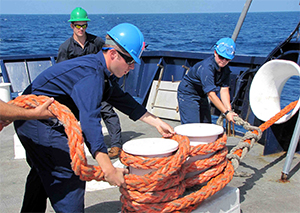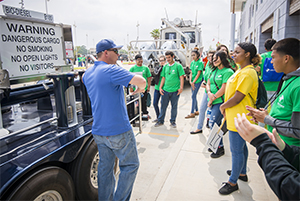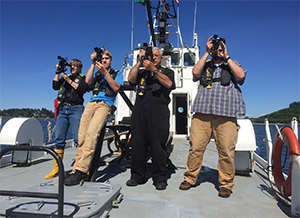It’s been dubbed the “silver tsunami” and according to a range of observers, it’s a significant threat to the health of the U.S. maritime industry. The problem is that, for a variety of reasons, the pool of talent from the deck to the bridge has been aging and dwindling, meaning that too few people have gone into or stayed in the maritime sector in recent decades.
In the United States, there are two specific impediments that must be faced, according to Mick Tansey, partner at Flagship Management, a maritime executive recruiter in Pompano Beach, Fla. The first is the decline of the U.S.-flagged merchant marine, and the second is the intrusion of non-maritime industries that are poaching talent.
In a recent U.S. Merchant Marine Academy graduating class, only about half of graduates found a position on a U.S.-flagged vessel, according to Tansey. That is a symptom of a larger problem: As the total number of U.S.-flagged ships has dropped, there have been fewer opportunities for graduates coming from maritime schools to ship out. “If you aren’t getting experience and there are no opportunities, you will choose to go into other fields,” he said. Typically, that means moving toward shipyards or maritime shore facilities.
Another factor in the mariner shortage is that more glamorous companies are scooping up recent engineering graduates. “If I had a choice of working for SpaceX or on a tanker, I would probably go for SpaceX,” Tansey said. Shore-based businesses also offer a more appealing work style for many younger people. “It can be hard to convince (them) that maritime is a good career choice,” he said.
From Tansey’s perspective, the situation is less dire on inland waterways, in port operations and at lower ranks. But he said a skills shortage is also evident in related fields such as government shipyards, where a large portion of the work force is approaching or has reached retirement age. “It is an alarming situation, but you don’t see much being done about that either,” he said. And a rigid government salary structure doesn’t help, he noted.
Echoing Tansey’s concerns, Sarah Scherer, director and associate dean at Seattle Maritime Academy at Seattle Central College, said the average age of a mariner in her region is 54. Furthermore, she said, half of the work force in the Washington State Ferries system — the largest in the United States — is eligible for retirement today. But this isn’t just a Washington problem, it is a world problem.
“An IMO study predicted that by 2025, we will be short 148,000 deck or ship officers worldwide,” Scherer said.
Traditionally, most of these trades have been passed down from father to son or cousin to cousin, she said. But changing times have doomed that approach. Nowadays, Scherer said, people in her state often opt to go into industries like health care or information technology because they are lucrative, “but for us maritime is actually quite big, too, with billions in revenue.”
She said most people don’t know that, including younger people making career choices. “I have lived in Houston and Jacksonville, both major port cities, and even in those places people just don’t seem to realize how vital the maritime world is, even though they see it every day,” Scherer said. “In the Pacific Northwest, the industry is very white and male. The problem is that we don’t have enough white males to fill the gap that is going to develop.”
 |
|
Cadets at California Maritime Academy train aboard T/S Golden Bear, the school’s flagship. Nearly 1,200 men and women graduated from the seven U.S. maritime academies in 2017. “At a time when our nation faces unpredictable threats, the need for qualified mariners is of critical importance due to their indispensable role in supporting the U.S. merchant marine,” said Thomas Allegretti, chairman of the American Maritime Partnership, in applauding the graduates. |
|
Courtesy California Maritime Academy |
In part, it is a question of shifting views about work. “This (millennial) generation has never been disconnected. They don’t know what it is like to be separated from friends and family, and they are the ones we are trying to recruit,” Scherer said. On many ships there is no Internet, you can’t stream data and you aren’t going to stay in touch using your cellphone. As a result, “we look for people who have traveled or been in the military and might be more prepared for that kind of separation,” she said.
While some might say the coming generation isn’t hardy enough, Scherer said that isn’t necessarily true. “They know how to work hard, but it is a different kind of work,” she said. “Some of our students come in and they have never seen tools. We call our maritime mechanics class ‘tool time.’” More broadly, she added, “society has been telling kids that if you don’t have a bachelor’s degree, you aren’t successful.”
Chuck Underwood, founder and principal at The Generational Imperative Inc., a consultancy in Miamisburg, Ohio, agreed that there are big differences between the retiring generation of mariners and those who might replace them, and it is a situation that affects all businesses.
He said the massive baby boom generation (ages 54 to 72 in 2018) is reaching retirement age and there are not nearly enough members of Generation X (ages 37 to 53 in 2018) to replace them. And the young millennials (ages 18 to 36 in 2018) have avoided careers in certain industries like maritime.
“There are always exceptions, but what began to happen with Gen X is they entered adulthood with an aversion to manual labor, which they considered dirty, unsafe and unable to deliver long-term job and income stability,” Underwood said.
Those attitudes were a reflection of the dismantling of the middle class, the movement of jobs overseas and chronic layoffs. Then, Gen X became the first generation — especially males, he noted — to be “swept away” by the personal computer and video games. “Instead of playing outdoors, sweating and getting dirty, they sat around playing video games hour after hour,” Underwood said. Millennials are following the same pattern, he said.
Retired Navy Rear Adm. Mark Buzby, recently appointed administrator of the U.S. Maritime Administration (MarAd), also is concerned about the problem and is searching for solutions. Citing results of a study conducted by the Maritime Transportation System National Advisory Committee, Buzby said he believes the nation is “about 1,800 mariners short for manning the (Military Sealift Command) fleet in ready reserve.” And that’s not even considering shortages on U.S.-flag vessels in regular service.
Buzby also cited the growing cost and complexity of national and international regulations, with strict medical exams required for many roles. That in itself is enough to deter some individuals, he said, but when compounded by the reduced opportunities to go out on the water, even more qualified mariners are probably going to let their credentials lapse.
 |
|
Calling all millennials: The Port of Houston was among the presenters last year at the Maritime and Logistics Youth Expo held at San Jacinto College’s Maritime Technology and Training Center in La Porte, Texas. Nearly 700 students attended the event, which featured career-oriented discussions about towboats, harbor tugs, barges, dredging, survey vessels and salvage equipment. |
|
Courtesy Port of Houston |
Among the potential solutions being examined are easing the path from the military into the merchant marine. Ironically, Buzby said, it is now much easier for individuals to move from the Army to the merchant marine than it is to transition from the Coast Guard or Navy.
“The Army watercraft operators have their training set up so that it generally matches civilian licensing requirements,” he said. “The Navy is working in that direction in some areas, but there is a cost-benefit analysis they must consider relative to their mission.” A result of these efforts is the recently developed Military to Mariner (M2M) program that aims to facilitate transitions for those seeking new careers.
Another area of focus could be the Jones Act. “Under the Obama administration, the requirements for the use of U.S. bottoms by the government were further relaxed, which contributed to a further reduction in vessels under the flag,” Buzby said. Revisiting those requirements is something to consider, he said.
Buzby also cited the Energizing American Maritime Act, a bill introduced last February by Rep. John Garamendi, D-Calif., that would have required more petroleum exports to be carried on U.S.-flagged vessels. The bill was referred to the House Subcommittee on Energy but advanced no further. Dante Atkins, communications director for the congressman, said Garamendi is aiming to introduce a fresh bill on the topic. “I don’t know at this point how similar or different it will be,” Atkins said.
Then there’s training. Scherer said Seattle Maritime Academy is working hard to attract potential new talent. At the high school level, the academy runs a four-day training event with a sampling of deck work, engine work, marine safety and even environmental science. “They get to go out on a vessel, collect data, and come back and do some career exploration,” she said. “We talk about every marine trade, including welding .and refrigeration tech, where you can pretty much write your own ticket.”
Scherer said another factor hurting recruitment at any age is the federal requirement for obtaining a Transportation Worker Identification Credential (TWIC). Under the Maritime Transportation Security Act, a TWIC is required for those who need access to secure areas of the nation’s maritime facilities and vessels. A range of felonies and other offenses can prevent someone from being granted a TWIC, including drug infractions and convictions for driving under the influence.
Most frustrating for Scherer, though, is having people with great potential who are interested in the academy’s programs but are unable to get time on the water to complete their credentials.
In short, the problem is bigger than just the “silver tsunami.” It’s symptomatic of the larger challenges facing the maritime field.

